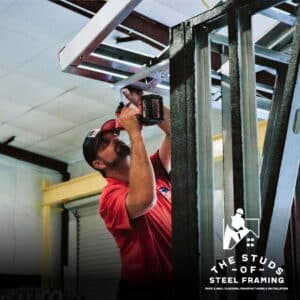Light Gauge Steel Framing vs. Traditional Wood Framing in Commercial Construction
When planning a commercial construction project, one of the first decisions developers must make is choosing the right framing material. While wood framing has been a traditional choice for decades, Light Gauge Steel (LGS) framing is quickly gaining popularity due to its numerous advantages in strength, durability, sustainability, and cost-effectiveness. In this post, we’ll compare LGS framing with traditional wood framing and explore why LGS is becoming the go-to solution for modern commercial construction.
1. Strength and Durability: LGS vs. Wood Framing
One of the most important factors in commercial construction is the strength and durability of the building’s framing system. Light Gauge Steel outperforms wood in several ways:
- Superior Strength: Steel’s strength-to-weight ratio is much higher than that of wood, making LGS framing a better option for structures that require long spans, large open spaces, or multiple stories. Steel can support more weight without compromising the building’s structural integrity.
- Resistance to Warping and Shrinking: Unlike wood, which can warp, shrink, or expand due to moisture, LGS framing maintains its shape and size over time. This helps prevent structural problems like misaligned walls or sagging roofs, ensuring the building remains sturdy for decades.
LGS framing provides greater strength and long-term durability than wood framing, making it the better option for large-scale or multi-story commercial projects.
2. Fire Resistance: Steel vs. Wood
When it comes to fire safety, Light Gauge Steel framing offers a significant advantage over wood:
- Non-Combustible Material: Steel does not catch fire or contribute to the spread of flames, making it a safer option for commercial buildings. In contrast, wood is highly combustible and can accelerate the spread of a fire.
- Compliance with Fire Codes: Many commercial buildings are required to meet strict fire safety codes. Using LGS framing helps developers meet or exceed these codes more easily, potentially reducing insurance premiums and increasing safety.
With its non-combustible properties, LGS framing provides enhanced fire safety, reducing the risk of fire-related damage and improving the overall safety of the building.
3. Sustainability and Environmental Impact
As more developers seek sustainable building solutions, the environmental impact of the framing material becomes an important consideration. Light Gauge Steel offers several sustainability advantages over wood:
- 100% Recyclable: Steel is fully recyclable, which means any waste produced during construction can be reused in future projects. This contributes to a closed-loop supply chain, reducing the demand for new raw materials and minimizing waste.
- Less Deforestation: Choosing LGS framing reduces the demand for timber, which helps preserve forests and natural habitats. By using steel, developers are making a more eco-friendly choice that aligns with modern sustainability goals.
- Reduced Material Waste: Because LGS components are prefabricated, less material is wasted during construction. In contrast, wood framing often results in more offcuts and scrap material that must be disposed of.
For developers focused on green building practices, LGS framing is the more sustainable option compared to wood, supporting eco-friendly construction with minimal environmental impact.
4. Resistance to Pests, Moisture, and Mold
In Florida’s humid climate, resistance to pests and moisture is a key factor when choosing a framing material. Light Gauge Steel is far superior to wood in this regard:
- Pest-Resistant: Steel is impervious to termites and other pests that can destroy wood-framed structures. This eliminates the need for expensive pest control treatments and reduces the risk of structural damage caused by infestations.
- Moisture and Mold Resistance: Steel does not absorb moisture, which makes it resistant to rot and mold. Wood, on the other hand, can easily absorb water, leading to mold growth and structural decay, especially in humid environments like Florida.
The moisture and pest resistance of LGS framing make it a low-maintenance, long-lasting solution for commercial buildings, especially in regions prone to high humidity.
5. Cost Comparison: Steel vs. Wood
While the initial cost of Light Gauge Steel framing can be higher than wood, the long-term cost benefits often outweigh the upfront investment:
- Lower Maintenance Costs: Because steel is resistant to fire, pests, and moisture, it requires far less maintenance than wood. This leads to lower long-term maintenance expenses for building owners, making LGS framing a more cost-effective choice over the life of the building.
- Fewer Repairs: Steel’s durability means fewer repairs are needed due to warping, rotting, or pest damage. In contrast, wood-framed buildings often require costly repairs to address these issues over time.
- Energy Savings: LGS framing helps improve energy efficiency by reducing thermal bridging, which lowers energy consumption and utility bills. This can lead to significant savings, especially in commercial buildings where energy costs are a major concern.
Though LGS framing may have a higher initial cost, its long-term savings in maintenance, repairs, and energy make it a more cost-effective option than wood.
6. Construction Speed and Flexibility
In fast-paced commercial construction, the ability to complete a project quickly and efficiently is crucial. Light Gauge Steel framing supports faster construction timelines compared to wood:
- Prefabrication for Quick Assembly: LGS components are manufactured off-site and arrive at the job site ready to be installed. This speeds up the framing process and reduces labor costs. Wood framing, by contrast, often requires more on-site cutting and assembly, which can slow down the project.
- Consistency in Quality: Steel is manufactured to precise specifications, ensuring uniformity and consistency in every component. Wood, being a natural material, can have inconsistencies like knots, splits, or warping that require additional time to work around during construction.
- Flexibility for Complex Designs: Steel’s strength and flexibility allow for more design options, such as open floor plans or multi-story buildings. This flexibility does not compromise construction speed, making LGS framing ideal for large-scale commercial projects with tight deadlines.
The faster construction timelines and design flexibility offered by LGS framing make it a better choice for developers who want to complete projects quickly while maintaining high-quality results.
Conclusion: Why Light Gauge Steel Outperforms Traditional Wood Framing
When comparing Light Gauge Steel framing to traditional wood framing, it’s clear that LGS offers superior strength, durability, fire resistance, sustainability, and long-term cost savings. Whether you’re developing a small commercial building or a large multi-story complex, LGS framing provides the structural integrity, environmental benefits, and design flexibility needed for modern commercial construction. For developers looking to build smarter, stronger, and more sustainable projects, LGS framing is the clear winner.
Contact Elite Steel Today! Ready to make the switch to Light Gauge Steel framing for your next commercial project? Contact Elite Steel at 1-904-799-6499 or visit elitesteel.com to learn more about the advantages of steel framing and get a customized quote.


